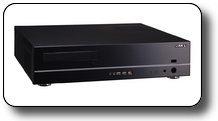07 May 2010

Just a reminder of what I was wanting for our HTPC:
- Low power
- Silent
- Powerful enough to run KDE fully
- DVI and HDMI interfaces
- Decent on-board sound
- Plenty of USB slots
- Needs to visually go with our HiFi amp and Blu-Ray player
- Powerful enough graphics to support 1080p (or 720p if not possible)
06 May 2010
We bought our current media centre in 2003, choosing Microsoft Windows XP Media Center Edition (XPMCE). This was a disaster. If it was an open source application, then I would say that the first edition of XPMCE was worse than Alpha quality, being utterly unusable. We upgraded to 2004 at the first opportunity, it was marginally better, possibly Alpha quality. At last we upgraded to 2005, and we had a barely usable system, Beta quality I would say. It still crashed regularly, but it no longer lost all our channel set-up every day or two.
Those that say that Linux is free if your time is free have never spent evening after evening setting up XPMCE.
30 Apr 2010
Despite all the fantastic tools around, making a Linux USB key seems to be inconsistent. Modern hardware seems to be fairly good, but older hardware may need fat 16 or fat 32 or superfloppy format. The eee pc 701 for example seemed to need superfloppy format to work.
21 Apr 2010

Job control turned off nbd0 not found
These instructions do not apply for Ubuntu.
If you receive an error message stating initramfs “job control turned off”, then look further up for a line stating that /path/to/nbd0 not found. If you’re on Debian then this is an indication that the client is trying to boot via NBD instead of NFS. Check the following:
Firstly, see if there is a directory /opt/ltsp/i386/images, this is the default directory for the ltsp-update-image generated unionfs files. If it exists you should probably delete it, reboot the client and all may be well.
30 Mar 2010

Introduction
Time to install a new server - yay! The hardware is an HP Proliant DL360 G5, with a single quad-core processor and 4GB ram. This page is about creating a complete desktop server and, as such, much of this is actually nothing to do with LTSP, but is all about setting up a functional and attractive desktop server.
Server Specification
30 Mar 2010

Paths
The ldm-theme is loaded from a symlink at:
/opt/ltsp/i386/usr/share/ldm/themes/default
30 Mar 2010

Command
Introduction
The ltsp-update-kernels script copies it into the chroot environment and automatically updates the symlinks for the boot loader in the process.
30 Mar 2010

Command
For systems that use NBD (not Debian), this command will create a client image from the contents of /opt/ltsp/i386, and store it in /opt/ltsp/i386/images.
Any change you make in the chroot will only take effect for the clients after you run ltsp-update-image. As such, this is the command that you will run most often.
30 Mar 2010

Command
Introduction
The ltsp-build-client command will download a complete Debian filesystem into /opt/ltsp/i386 (or specify an alternate location with --base) and install the ltsp-client and ldm (LTSP Display Manager) packages. As such, you will probably only run this command the first time you install LTSP5.
30 Mar 2010

Command
Introduction
Secure Shell Handler or SSH is a network protocol that allows data to be exchanged using a secure channel between two computers. LTSP uses it to enable secure communication between clients and the Server. SSH uses public-key cryptography to authenticate the client, this command rebuilds the keys.


